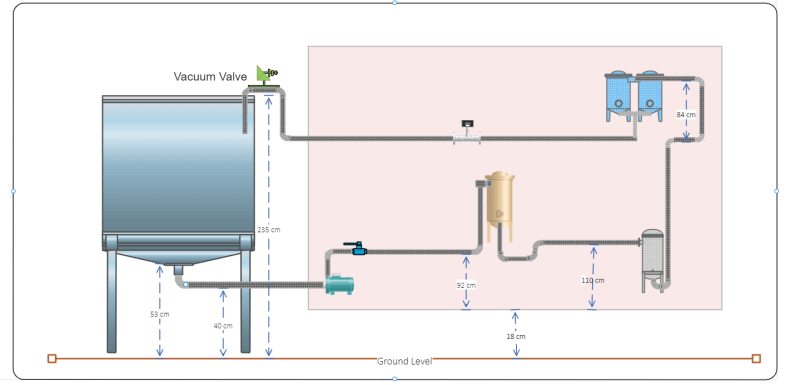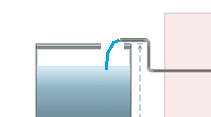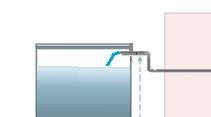I want to modify an existing filter test setup with a 2 inch piping. The usual flow rates are 10 m3/hr and higher. To be able to test a different type of filter for which flow rates are quite low 1 -3 m3/hr on the same system I doubt that the pipes will remain full. The test fluid is water. Is there a way to calc. what is the minimum flow rate for the existing pipes to keep them full at all times?
Navigation
Install the app
How to install the app on iOS
Follow along with the video below to see how to install our site as a web app on your home screen.
Note: This feature may not be available in some browsers.
More options
Style variation
-
Congratulations cowski on being selected by the Eng-Tips community for having the most helpful posts in the forums last week. Way to Go!
You are using an out of date browser. It may not display this or other websites correctly.
You should upgrade or use an alternative browser.
You should upgrade or use an alternative browser.
Target flow rate for a full pipeline 2
- Thread starter Muud
- Start date
- Status
- Not open for further replies.
LittleInch
Petroleum
Yes there is, but a lot then depends on the slope and how the pipe empties to atmosphere.
You could simply install an upside down U bend with the top higher than your filter to maintain a full pipe.
Only if your downstream pipe is sloping continuously to an open end will the water run out faster than it comes in and hence get open channel flow.
It's not a big issue though so not sure why you're concerned?
A decent sketch and profile would be useful to see if you've got an issue or not.
Remember - More details = better answers
Also: If you get a response it's polite to respond to it.
You could simply install an upside down U bend with the top higher than your filter to maintain a full pipe.
Only if your downstream pipe is sloping continuously to an open end will the water run out faster than it comes in and hence get open channel flow.
It's not a big issue though so not sure why you're concerned?
A decent sketch and profile would be useful to see if you've got an issue or not.
Remember - More details = better answers
Also: If you get a response it's polite to respond to it.
- Thread starter
- #3
The pipe empties the water back into the main tank (open) so forming a closed loop.
If there is a partially full flow then it will be an issue for the electromagnetic flow measurement, inline sampling as well as for other sensors.
I am preparing a sketch and will upload it here. It will give you a much clearer idea of the existing setup.
If there is a partially full flow then it will be an issue for the electromagnetic flow measurement, inline sampling as well as for other sensors.
I am preparing a sketch and will upload it here. It will give you a much clearer idea of the existing setup.
LittleInch
Petroleum
If the pipe empties above the water line in the tank then it's an open loop. A closed loop would be if it entered the tank under the water level.
A simple high point with a vacuum breaker will create and maintain a full pipe at any flow including zero. A valve will only help if you have sufficient flow to blow all the bubbles out.
Remember - More details = better answers
Also: If you get a response it's polite to respond to it.
A simple high point with a vacuum breaker will create and maintain a full pipe at any flow including zero. A valve will only help if you have sufficient flow to blow all the bubbles out.
Remember - More details = better answers
Also: If you get a response it's polite to respond to it.
- Thread starter
- #6
I have drawn the sketch and hopefully it gives you a clear idea of the layout.

The pipe elevations shown on the platform are measured w.r.t. the platform and thus those without any height are not elevated.
Is a vacuum breaker valve same as an air release valve?

The pipe elevations shown on the platform are measured w.r.t. the platform and thus those without any height are not elevated.
Is a vacuum breaker valve same as an air release valve?
LittleInch
Petroleum
Ok, To make your system always full then simply make your last set of connections past the meter to include an inverted U bend, with the pipe higher than 110cm off the platform and insert a vacuum breaker on the high point. The route the down pipe in a continuous slope or flat into your tank ABOVE the water line in the tank.
A vacuum breaker lets air in, an air release valve lets air out. Sometimes they can be the same thing, sometimes not. always check.
Remember - More details = better answers
Also: If you get a response it's polite to respond to it.
A vacuum breaker lets air in, an air release valve lets air out. Sometimes they can be the same thing, sometimes not. always check.
Remember - More details = better answers
Also: If you get a response it's polite to respond to it.
- Thread starter
- #8
- Thread starter
- #9
LittleInch
Petroleum
Well this is only for the last bit of piping as it drains into the tank.
But the high point downstream of the meter will mean that regardless of your flow rate, the pipes will always be full of liquid so long as you either vent the filters etc or flow at a high enough velocity initially to blow out all the air bubbles.
You want to drain above the water level so that you don't get any air locks or two phase flow going on. Much simpler to just empty above the water line.
on the other hand, if your current set up is below the water line then you may not have a problem providing that you can eliminate the air once you've changed equipment.
At its simplest a vacuum valve is just a bit of pipe open to atmosphere sticking vertically up for say 1m as the pressure drop in your last bit of pipe will be very low.
Remember - More details = better answers
Also: If you get a response it's polite to respond to it.
But the high point downstream of the meter will mean that regardless of your flow rate, the pipes will always be full of liquid so long as you either vent the filters etc or flow at a high enough velocity initially to blow out all the air bubbles.
You want to drain above the water level so that you don't get any air locks or two phase flow going on. Much simpler to just empty above the water line.
on the other hand, if your current set up is below the water line then you may not have a problem providing that you can eliminate the air once you've changed equipment.
At its simplest a vacuum valve is just a bit of pipe open to atmosphere sticking vertically up for say 1m as the pressure drop in your last bit of pipe will be very low.
Remember - More details = better answers
Also: If you get a response it's polite to respond to it.
- Thread starter
- #11
To incorporate both a u-bend and discharge of the return path, I am thinking of combining the two. Something like the following:

I suppose if the pump can cope with the increased discharge head, we can implement the setup without creating other problems. Do you see other potential issues?

I suppose if the pump can cope with the increased discharge head, we can implement the setup without creating other problems. Do you see other potential issues?
LittleInch
Petroleum
Looks good to me.
If you want to ensure a full pipe at all times then something needs to change and this looks like a simple piping change to me.
When you change the test element there will be a little bit more water to drain out but pretty small.
Remember - More details = better answers
Also: If you get a response it's polite to respond to it.
If you want to ensure a full pipe at all times then something needs to change and this looks like a simple piping change to me.
When you change the test element there will be a little bit more water to drain out but pretty small.
Remember - More details = better answers
Also: If you get a response it's polite to respond to it.
- Thread starter
- #13
LittleInch
Petroleum
Please let us know if it works(!)
Remember - More details = better answers
Also: If you get a response it's polite to respond to it.
Remember - More details = better answers
Also: If you get a response it's polite to respond to it.
LittleInch
Petroleum
Just stops the system syphoning down. Maybe not needed but they are simple and cheap.
Remember - More details = better answers
Also: If you get a response it's polite to respond to it.
Remember - More details = better answers
Also: If you get a response it's polite to respond to it.
- Thread starter
- #17
LittleInch
Petroleum
what ever.
So long as the highest point on the system is at the top of that pipework, it matters not.
Remember - More details = better answers
Also: If you get a response it's polite to respond to it.
So long as the highest point on the system is at the top of that pipework, it matters not.
Remember - More details = better answers
Also: If you get a response it's polite to respond to it.
- Status
- Not open for further replies.
Similar threads
- Replies
- 9
- Views
- 1K
- Locked
- Question
- Replies
- 7
- Views
- 901
- Locked
- Question
- Replies
- 3
- Views
- 6K
- Locked
- Question
- Replies
- 13
- Views
- 1K
- Replies
- 9
- Views
- 632


